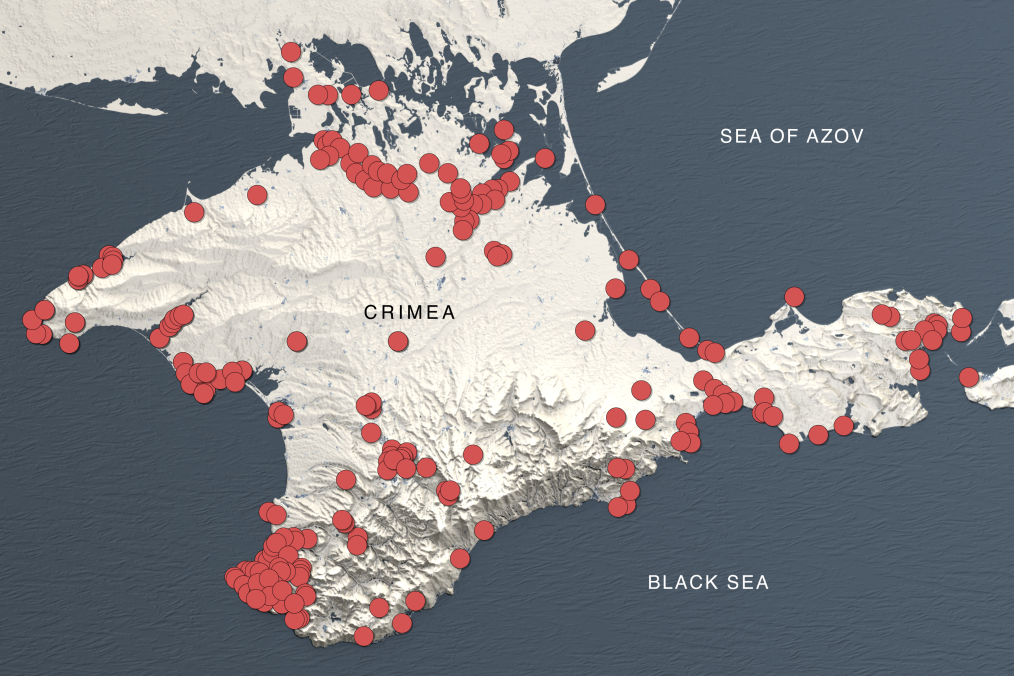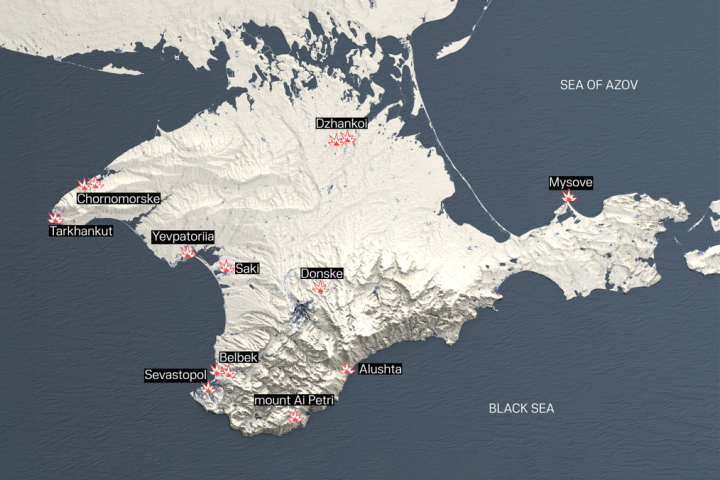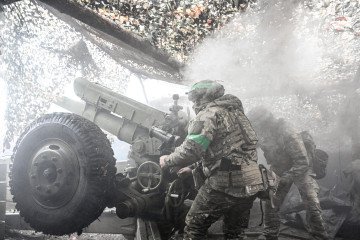- Category
- War in Ukraine
Russia Has Heavily Militarized Crimea, And Made a Human Shield for Its 233 Military Objects

Russian-occupied Crimea is one of the most fortified zones in the war in Ukraine, housing more than 233 military objects. The Black Sea Peninsula is known as "a military haven" from which Russia launches large-scale military operations against Ukrainian civilians and civilian infrastructure. However, it also encourages people to vacation there.
In 1783, the Russian Empire occupied Crimea, and since then, Russia has been fixated on militarizing the peninsula. Even during the Soviet Union era, Russian politicians and media closely aligned with them referred to it as the "unsinkable aircraft carrier." When Russia illegally occupied Crimea—part of Ukraine—again in 2014, it continued its quest to expand its military presence there.
Sevastopol, Crimea’s largest city, is particularly significant as a major port on the Black Sea that houses Russia's Black Sea Fleet. Sevastopol has enabled Russia to project naval power on a global level while providing a safe haven for its long-range missile systems to strike Ukraine regularly.
Since the beginning of Russia’s full-scale invasion of Ukraine, the Ukrainian Armed Forces have questioned the "unsinkability" of Russia’s military targets in Crimea. In June, The Economist published an article titled "In Crimea, Ukraine is beating Russia."
Recently, Ukraine has increased its attacks against Sevastopol, where many military headquarters, targets, and bases are positioned, such as their Black Sea command post. There have also been several strikes on Belbek, an air base from which fighter jets are launched that regularly target Ukrainian civilian infrastructure.
Ukraine has only ever targeted military positions in Crimea, never civilian ones. Yet Russia allows its civilians to continue life as normal within meters of these 233 military positions—deliberately violating International Humanitarian Law.
Crimea: A militarized “unsinkable aircraft carrier”
Russia has been occupying Crimea since 2014. Before its illegal annexation, it was home to the Crimean Tatars and a popular tourism destination for many. But now, it is a heavily militarized zone with 233 military bases recorded by journalists from Radio Free Europe Radio Liberty.

This more detailed map shows:
Airfields.
Bases of the Russian Black Sea Fleet.
Military headquarters.
Air defense systems.
Training grounds.
Fuel stations.
Ammunition depots.
Radar sites.
Crimea is Ukrainian territory—temporarily occupied by Russia—and therefore, restrictions placed by the U.S. on striking military targets within Russia with ATACMS don’t apply to it. Ukraine is granted permission by the U.S. to strike anywhere on its own soil occupied by Russian forces.
Military targets in Sevastopol
As pinpointed on the map, Sevastopol is home to, but not limited to:
Several air-defense bases housing S-300 and S-400 systems.
Several headquarters for various anti-aircraft, naval, reconnaissance, and air-defense forces.
Osa anti-aircraft complexes.
Several missile warehouses and depots.
Radiological and chemical weapons.
Air-defense positions.
Airfields.
Military equipment sites.
Radar bases.
Fuel warehouses.
Repair warehouses
…and much more.
Belbek Airfield, just outside of Sevastopol, hosts Sukhoi Su-27 and Sukhoi Su-30 fighters, Russian Navy Mikoyan MiG-31 interceptors, Navy Mikoyan MiG-29K fighters, and more. The MiG-31 is one of the most dangerous warplanes used in this war, capable of firing radar-guided R-27 missiles over 200 miles.
Recently, Sevastopol and Belbek airfield have been subjected to several strikes by Ukraine. For example, according to Ukraine's General Staff, on June 12th, 2024, a missile strike successfully targeted an “S-300 anti-aircraft missile division, as well as two S-400 anti-aircraft missile divisions.” They added that “Two radars of the S-300 and S-400 complexes were destroyed along with the detonation of munitions.”
In addition, Ukraine has been successfully destroying Russian air defense systems in Crimea.

Approximately 15 individual air defense systems have been struck, specifically modifications of the S-300, S-350, and S-400 systems. Dozens of launcher units of these systems have been destroyed, along with over 15 radar stations and more than ten command posts.
As mentioned earlier, analysts say the Ukrainian military is preparing to increase its reliance on air support for ground operations once enough Western fighter jets, including F-16s and Mirages, are available. Therefore, Ukraine is targeting Russian air defense to secure the airspace.
Is Russia using civilians as human shields?
According to the Institute for the Study of War, “Russian authorities have irresponsibly encouraged Russian tourism to occupied Crimea during wartime” and are likely “purposefully stationing military targets nearby civilian areas in Crimea” to deter Ukrainian strikes. This is also in direct violation of International Humanitarian Law, as most military positions, according to the map, are within heavily populated areas like Sevastopol.
Sevastopol and Belbek military positions have been under heavy fire for more than a month; it seems negligent to allow tourists to flood a nearby beach. It is clear that Russian occupation authorities have done very little to protect civilians. Russia has used this tactic in other occupied regions by stationing military equipment within school grounds.
The Ukrainian government implements as many protective measures as possible to protect people. For instance, in Avdiivka in 2023, Vitalii Barabash, the city's Chief Military Administrator, attempted to forcefully remove all children from the city as the fighting became ever more life-threatening. The Emergency Services worked with Barabash’s authorities to persuade families to leave, promising to provide them with a safe place to be housed. This has not been an isolated occurence.
Throughout the war, Ukraine has implemented as many preventative measures as possible. In contrast, in Crimea, Russia seems to be strategically using civilians as human shields and making critical and costly errors—failing to advise and evacuate beachgoers efficiently.
Crimea has a vast number of military targets that must be destroyed to make significant changes in this war. Will Russia begin to prioritize the lives of ordinary people? Or will waging war and terror against Ukraine continue to be a superior aim?
-46f6afa2f66d31ff3df8ea1a8f5524ec.jpg)
-531fe8d92c87f1630d3f1a2503c33089.png)


-29a1a43aba23f9bb779a1ac8b98d2121.jpeg)
-886b3bf9b784dd9e80ce2881d3289ad8.png)


-f88628fa403b11af0b72ec7b062ce954.jpeg)